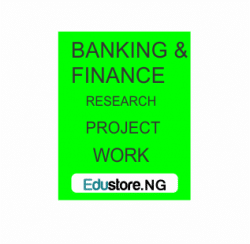Effect Of Automated Teller Machine On The Performance Of Nigerian Banks
abstract of Effect Of Automated Teller Machine On The Performance Of Nigerian Banks
This study examines the effect of Automated Teller Machine on the performance of the Nigeria bank in the banking industry in Nigeria. The objective of the study was to determine the contribution of ATM on the effectiveness of the banking sector, to determine the extent to which ATM has stimulate growth in the banking system and to examine the extent to which ATM has speedily improve bank profitability. The focus of this study is on three (3) banks to include Access bank, First Bank and Diamond bank. Primary data were source of data collection for this study, and the data were collected through the use of structured questionnaire. A total of 100 respondents was sample for this study. The survey research design was the research design adopted for this study. The simple percentage and the chi-square statistical tool were used for the analysis of the data. The findings revealed that there is a significant relationship between ATM and effectiveness of banking system. Also it was revealed that there is a significant relationship between ATM and its ability to stimulate growth of the banking sector. It is concluded that ATM contributes to the effectiveness of the banking system. Also, it was concluded that ATM speedily improve the profitability of the banks. It was recommended that Automated Teller Machine (ATM) should be located in banks and customers convenience areas. This allows customers to drive up and complete financial transaction without ever leaving the safety of their belongings.
Chapter one of Effect Of Automated Teller Machine On The Performance Of Nigerian Banks
INTRODUCTION
1.1 OVERVIEW OF THE STUDY
In today’s business world, globalization and international experience has become critically important. Banking industries can no longer get away with operating loosely connected groups of businesses that happen to be located around the world, but must strategically integrate their activities.
Mitroff [1] stated that, only the banks, businesses, industries, and whole by societies that clearly understand the new rules of doing business in a world economy will prosper. Global competition in the banking sectors has forced management and executives to recognize that they must think differently about banking activities and management. As a global banking, the only way to succeed is to develop an effective global banking management system with personnel capable of designing and implementing transnational business strategies through the use of modern technology such as automated teller machines (ATMs).Technology has tremendously stimulated expansion of the banking networks and range of the offered services during recent years. All banking services, such as electronic payments, loans, deposits, or securities have become heavily dependable on information and telecommunication technology. This is the main reason why banks are the biggest users of modern technology equipment. Due to the complexity of banking services, every opportunity to speed up their performance or to make them more accessible for customers is very well welcomed by banks.
- For Reference Only: Materials are for research, citation, and idea generation purposes and not for submission as your original final year project work.
- Avoid Plagiarism: Do not copy or submit this content as your own project. Doing so may result in academic consequences.
- Use as a Framework: This complete project research material should guide the development of your own final year project work.
- Academic Access: This platform is designed to reduce the stress of visiting school libraries by providing easy access to research materials.
- Institutional Support: Tertiary institutions encourage the review of previous academic works such as journals and theses.
- Open Education: The site is maintained through paid subscriptions to continue offering open access educational resources.





